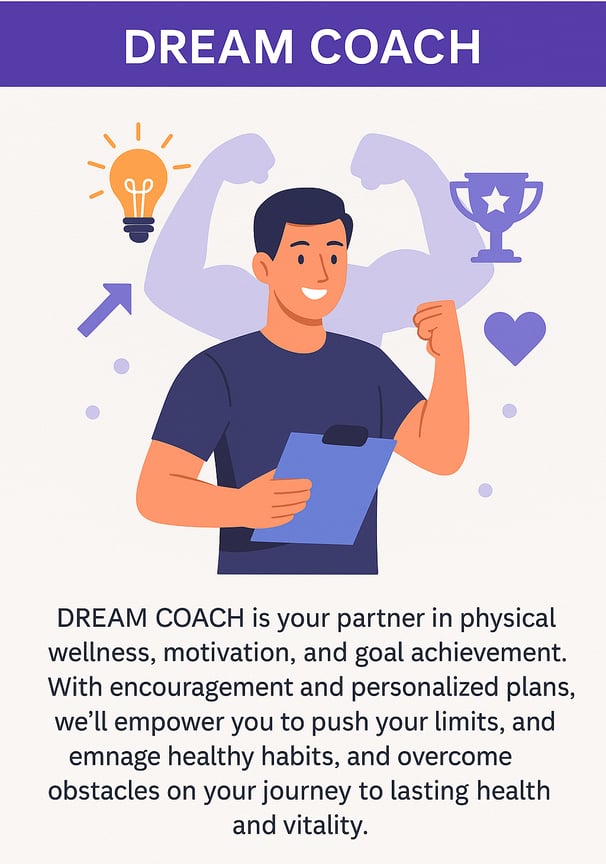Level 2 - 100 Expanded Coaching Suggestions for Holistic Well-Being
Level 2:
100 Expanded Coaching Suggestions for Holistic Well-Being
Start your day with a full-body stretch before getting out of bed.
Roll your shoulders back periodically to reduce tension.
Take deep belly breaths to activate the parasympathetic nervous system.
Engage in mindful walking—notice the sensations in your feet.
Try yoga poses that focus on spinal mobility.
Stand up and move every 30 minutes to counteract prolonged sitting.
Strengthen your balance with single-leg exercises.
Stretch your neck gently to relieve stress from screen time.
Incorporate micro-movements throughout the day, like ankle rolls.
Shake out tension from the hands and wrists after long periods of typing.
Use your breath to guide movements—inhale to lengthen, exhale to soften.
Maintain awareness of how movement affects your emotional state.
Move with rhythm—music can enhance motivation and coordination.
Make movement playful; dance spontaneously.
Explore tai chi for fluid, meditative motion.
Ground yourself by standing barefoot on natural surfaces.
Use your arms in expressive ways to release tension.
Stretch your hips daily to improve mobility and comfort.
Strengthen your lower back to prevent stiffness.
Use gentle twists to support spinal health.
Try deep lunges to open up the hips and thighs.
Develop a movement routine that fits your energy levels.
Rotate your joints in slow circles to lubricate them.
Keep your knees soft while standing to avoid joint strain.
Engage in mindful strength training—focus on controlled movement.
Use resistance bands for gentle, joint-friendly strength building.
Find an accountability partner for movement goals.
Set small movement goals rather than rigid workout expectations.
Stretch your arms overhead periodically to relieve upper-body tension.
Incorporate light bouncing (rebounding) for lymphatic stimulation.
Pay attention to how posture affects confidence and mood.
Strengthen your feet with toe exercises.
Focus on elongation rather than intensity in movement.
Try slow, deliberate squats to improve leg strength.
Explore breathwork techniques like alternate nostril breathing.
Use foam rollers or massage balls for myofascial release.
Engage in movements that mimic natural motions—crawling, squatting, reaching.
Allow your breath to dictate the pace of movement.
Try chair-based stretches if mobility is limited.
Start small—one mindful movement per day creates momentum.
Try controlled shaking or tremoring to release tension.
Perform spinal wave motions to maintain flexibility.
Move your eyes in all directions to support eye muscle function.
Be patient—progress in movement comes through consistency.
Focus on how movement makes you feel rather than just the results.
Try dynamic stretching before exercise and static stretching after.
Maintain hydration to support movement recovery.
Experiment with primal movements—rolling, crawling, hanging.
Move outside when possible to integrate with natural rhythms.
Use visualization—imagine the movement before performing it.
Release jaw tension with simple face exercises.
Engage in long, slow breathing while stretching.
Move your spine in all directions daily—forward, backward, sideways, twist.
Strengthen your grip—it’s connected to overall physical health.
Try restorative yoga for deep relaxation and release.
Use controlled shaking to reset the nervous system.
Dance to one song every day, no matter how short.
Experiment with improvisational movement—let your body guide you.
Alternate between periods of movement and stillness.
Engage your senses while moving—feel textures, listen deeply.
Adjust your movement style based on what your body needs today.
Use movement to release frustration—punch a pillow, stomp the ground.
Stretch before bed to improve sleep quality.
Try eye exercises to relieve strain from screens.
Adjust your breath to match different types of movement.
Rotate your wrists and ankles to maintain joint health.
Work with gravity—use slow, descending movements for control.
Shake your arms and legs loose when feeling stuck.
Strengthen the back body for better posture and ease.
Try meditative walking, syncing steps with breath.
Use movement breaks to counteract emotional stress.
Release tension in the shoulders with slow circles.
Experiment with breath pacing—4 seconds inhale, 4 seconds exhale.
Walk in nature to stimulate deeper relaxation.
Sit cross-legged occasionally to improve hip mobility.
Train coordination by moving opposite limbs together.
Try movement sequences that feel intuitive, not forced.
Reconnect with childhood movement—jump, skip, climb.
Use rolling and rocking movements to self-soothe.
Shift weight from one foot to the other for balance awareness.
Integrate gentle spinal flexion into your daily routine.
Try Qigong exercises to cultivate energy flow.
Use a balance board to challenge stability.
Stretch deeply only after warming up.
Move slowly and deliberately to enhance muscle control.
Strengthen hand dexterity with small object exercises.
Walk backwards occasionally to develop coordination.
Use simple stretches to relieve midday fatigue.
Keep a movement journal to track patterns and progress.
Shift sitting positions frequently to prevent stiffness.
Allow micro-movements—wiggling fingers, rolling shoulders—to maintain flow.
Develop a stretching ritual before sleep.
Train proprioception—your body’s sense of position—through slow, mindful movement.
Try laughter yoga—it’s movement and joy combined.
Explore movement with no agenda—just enjoy how it feels.
Tap rhythmically on different parts of your body to stimulate circulation.
Do a few gentle backbends daily to counteract forward posture.
Incorporate breath holds into your movement practice for greater lung capacity.
Use your non-dominant hand in activities to enhance brain-body connection.
Never underestimate the power of a single deep breath before movement.


© 2025. DREAMHEALER.ORG All rights reserved.
